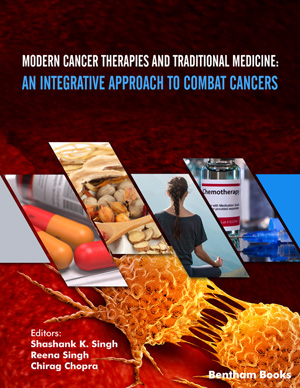
Abstract
Cancer is one of the biggest threats to human health with a global incidence of 23.6 million, mortality of 10 million, and an estimated 250 million lost in disability-adjusted life years (DALYs) each year. Moreover, the incidence, mortality, and DALYs have increased over the past decade by 26.3%, 20.9%, and 16.0%, respectively. Despite significant evolutions in medical therapy and advances in the DNA microarray, proteomics technology, and targeted therapies, anticancer drug resistance continues to be a growing concern and invites regular discovery of potent agents. One such agent is the microbe-producing bioactive compounds like Streptomyces, which are proving increasingly resourceful in anticancer therapy of the future. Streptomyces, especially the species living in extreme conditions, produce bioactive compounds with cytolytic and anti-oxidative activity which can be utilized for producing anticancer and chemo-preventive agents. The efficacy of the derived compounds has been proven on cell lines and some of these have already established clinical results. These compounds can potentially be utilized in the treatment of a variety of cancers including but not limited to colon, lung, breast, GI tract, cervix, and skin cancer. The Streptomyces, thus possess the armory to fuel the anticancer agents of the future and help address the problem of rising resistance to currently available anti-cancer drugs. We conducted a state-of-art review using electronic databases of PubMed, Scopus, and Google scholar with an objective to appraise the currently available literature on Streptomyces as a source of anti-cancer agents and to compile the clinically significant literature to update the clinicians.
Graphical Abstract
[http://dx.doi.org/10.1002/ijc.33588] [PMID: 33818764]
[http://dx.doi.org/10.1016/S0928-0987(00)00114-7] [PMID: 11033070]
[http://dx.doi.org/10.1002/path.1706] [PMID: 15641020]
[http://dx.doi.org/10.1126/science.aaa4972]
[http://dx.doi.org/10.1099/jmm.0.001232] [PMID: 32692643]
[http://dx.doi.org/10.3390/molecules25225365] [PMID: 33212836]
[http://dx.doi.org/10.1016/j.bjid.2012.08.014] [PMID: 22975171]
[http://dx.doi.org/10.1038/s41598-019-39592-6] [PMID: 30816228]
[http://dx.doi.org/10.2174/138161210789941847] [PMID: 20214614]
[http://dx.doi.org/10.7150/ijms.3635] [PMID: 22408567]
[http://dx.doi.org/10.3748/wjg.v20.i4.877] [PMID: 24574762]
[http://dx.doi.org/10.2174/092986711794480177] [PMID: 21143113]
[http://dx.doi.org/10.1038/nrclinonc.2016.25] [PMID: 26977780]
[http://dx.doi.org/10.1007/978-1-4939-3347-1_1]
[http://dx.doi.org/10.3390/cancers6031769] [PMID: 25198391]
[http://dx.doi.org/10.1128/MMBR.00005-07] [PMID: 17804669]
[http://dx.doi.org/10.1093/nar/gkt1111] [PMID: 24243842]
[http://dx.doi.org/10.1099/00207713-51-3-797] [PMID: 11411701]
[http://dx.doi.org/10.1007/0-387-30743-5_22]
[http://dx.doi.org/10.1038/ja.2012.27] [PMID: 22511224]
[http://dx.doi.org/10.1038/ncomms12467] [PMID: 27514833]
[http://dx.doi.org/10.1038/s41437-019-0196-0] [PMID: 31189905]
[http://dx.doi.org/10.1038/417141a] [PMID: 12000953]
[http://dx.doi.org/10.1155/2019/5283948] [PMID: 31354829]
[http://dx.doi.org/10.1039/b808743a] [PMID: 19030606]
[http://dx.doi.org/10.1007/s11274-010-0415-6]
[http://dx.doi.org/10.1016/j.micres.2004.10.006] [PMID: 15881828]
[http://dx.doi.org/10.1007/s11274-009-0040-4]
[http://dx.doi.org/10.1038/ja.2008.24] [PMID: 19198633]
[http://dx.doi.org/10.1021/np300902g] [PMID: 23662937]
[http://dx.doi.org/10.17179/excli2015-632] [PMID: 26600744]
[http://dx.doi.org/10.1021/acs.joc.5b01878] [PMID: 26402731]
[http://dx.doi.org/10.1021/jo401974g] [PMID: 24266328]
[http://dx.doi.org/10.3390/md15050144] [PMID: 28534807]
[http://dx.doi.org/10.1371/journal.pone.0244385] [PMID: 33347500]
[http://dx.doi.org/10.1128/MMBR.00019-15] [PMID: 26609051]
[http://dx.doi.org/10.1038/ja.2008.16] [PMID: 19132062]
[http://dx.doi.org/10.2478/s11535-012-0036-1]
[http://dx.doi.org/10.1002/chin.200609223]
[http://dx.doi.org/10.1186/2193-1801-2-93] [PMID: 23741637]
[http://dx.doi.org/10.4172/2155-9910.1000137]
[http://dx.doi.org/10.1016/j.jksus.2020.02.005]
[http://dx.doi.org/10.1007/s12275-011-1260-5] [PMID: 22203554]
[http://dx.doi.org/10.3390/molecules15031161] [PMID: 20335971]
[http://dx.doi.org/10.1007/s00284-018-1517-x] [PMID: 29869093]
[http://dx.doi.org/10.1021/np200320u] [PMID: 21553813]
[http://dx.doi.org/10.1007/s00792-017-0976-5] [PMID: 29101684]
[http://dx.doi.org/10.3390/md13031304] [PMID: 25786061]
[http://dx.doi.org/10.1021/np900160g] [PMID: 19921834]
[http://dx.doi.org/10.1021/acs.jnatprod.8b00449] [PMID: 30251851]
[http://dx.doi.org/10.1155/2018/4823126] [PMID: 29805975]
[http://dx.doi.org/10.1016/j.foodchem.2004.04.030]
[http://dx.doi.org/10.3389/fmicb.2016.00899] [PMID: 27379040]
[http://dx.doi.org/10.3389/fmicb.2017.00877] [PMID: 28559892]
[http://dx.doi.org/10.7164/antibiotics.42.1879] [PMID: 2621170]
[http://dx.doi.org/10.1016/j.tetlet.2016.05.042]
[http://dx.doi.org/10.1007/s10482-015-0431-5] [PMID: 25863667]
[http://dx.doi.org/10.1099/ijs.0.065045-0] [PMID: 24994773]
[http://dx.doi.org/10.1099/ijs.0.032201-0] [PMID: 21515699]
[http://dx.doi.org/10.5772/intechopen.94180]
[http://dx.doi.org/10.1016/j.mycmed.2013.04.005] [PMID: 23706303]
[http://dx.doi.org/10.1016/j.colsurfb.2010.07.036] [PMID: 20705438]
[http://dx.doi.org/10.2147/IJN.S82707]
[http://dx.doi.org/10.1049/iet-nbt.2016.0222] [PMID: 29155396]
[http://dx.doi.org/10.1016/j.cbi.2019.04.035] [PMID: 31059704]
[http://dx.doi.org/10.1007/s00284-019-01638-3] [PMID: 30706083]
[http://dx.doi.org/10.1016/j.biopha.2020.110322] [PMID: 32505822]
[http://dx.doi.org/10.1007/s00114-001-0283-x] [PMID: 12008969]
[http://dx.doi.org/10.3390/md12052590] [PMID: 24798926]
[http://dx.doi.org/10.1099/ijs.0.028258-0] [PMID: 21148669]
[http://dx.doi.org/10.1099/ijs.0.000497-0] [PMID: 19244424]
[http://dx.doi.org/10.1186/s12866-019-1409-7] [PMID: 30760201]
[http://dx.doi.org/10.1038/srep24247] [PMID: 27072394]
[http://dx.doi.org/10.1038/s41598-020-58623-1] [PMID: 32019976]
[http://dx.doi.org/10.3390/cancers11111742] [PMID: 31698795]
[http://dx.doi.org/10.3389/fmicb.2015.01316] [PMID: 26635777]
[http://dx.doi.org/10.3322/caac.21332] [PMID: 26742998]
[http://dx.doi.org/10.36877/pmmb.a0000002]
[http://dx.doi.org/10.1016/1074-5521(95)90120-5] [PMID: 9383461]
[http://dx.doi.org/10.7150/jca.47470] [PMID: 32742461]
[http://dx.doi.org/10.3389/fphar.2018.01300] [PMID: 30483135]
[http://dx.doi.org/10.1002/0471141755.ph0547s70] [PMID: 26331889]
[http://dx.doi.org/10.1016/j.bbcan.2013.12.002] [PMID: 24361676]
[http://dx.doi.org/10.1111/j.2042-7158.2012.01567.x] [PMID: 23278683]
[http://dx.doi.org/10.1182/blood.V41.5.721.721] [PMID: 4121004]
[http://dx.doi.org/10.3390/pharmaceutics5020294] [PMID: 24300452]
[http://dx.doi.org/10.3390/ijms12053303] [PMID: 21686186]
[http://dx.doi.org/10.1002/9783527807093.ch3]
[http://dx.doi.org/10.1016/j.ejpb.2015.03.018] [PMID: 25813885]
[http://dx.doi.org/10.1016/j.nantod.2013.04.006] [PMID: 23888183]
[http://dx.doi.org/10.2174/138920009790274540] [PMID: 20214578]
[http://dx.doi.org/10.2165/00003495-199700544-00005] [PMID: 9361957]
[http://dx.doi.org/10.1053/j.seminoncol.2004.08.002] [PMID: 15717736]
[http://dx.doi.org/10.1002/(SICI)1097-0215(20000401)86:1<108::AID-IJC17>3.0.CO;2-8] [PMID: 10728603]
[http://dx.doi.org/10.1007/BF00874153] [PMID: 7505268]
[http://dx.doi.org/10.1002/adma.202107964] [PMID: 35100658]
[http://dx.doi.org/10.1007/s11434-011-4747-x]
[http://dx.doi.org/10.3390/cancers3011081] [PMID: 24212654]
[http://dx.doi.org/10.1007/s13205-017-0930-3]
[http://dx.doi.org/10.1007/s00253-014-5953-7] [PMID: 25158833]
[http://dx.doi.org/10.3390/molecules26216414] [PMID: 34770823]
[http://dx.doi.org/10.3390/molecules27010212] [PMID: 35011443]
[http://dx.doi.org/10.1016/j.sjbs.2021.08.084] [PMID: 35002413]
[http://dx.doi.org/10.1016/j.ejar.2016.05.004]
[http://dx.doi.org/10.21608/ejabf.2019.26508]
[http://dx.doi.org/10.1002/tox.23128] [PMID: 33713530]
[http://dx.doi.org/10.1038/ja.2011.96] [PMID: 22008702]
[http://dx.doi.org/10.1002/anie.200804890] [PMID: 19090514]
[http://dx.doi.org/10.1021/ol301343n] [PMID: 22694269]
[http://dx.doi.org/10.1039/C8OB02775G] [PMID: 30543262]
[http://dx.doi.org/10.1021/np2008335] [PMID: 22304344]
[http://dx.doi.org/10.1517/14728222.2013.740461] [PMID: 23293836]
[http://dx.doi.org/10.3389/fmicb.2015.01398] [PMID: 26733951]
[http://dx.doi.org/10.1038/s41429-018-0096-1] [PMID: 30158647]
[http://dx.doi.org/10.1021/ol3008638] [PMID: 22519738]
[http://dx.doi.org/10.1016/S2221-1691(11)60199-8] [PMID: 23569875]
[http://dx.doi.org/10.1016/j.cclet.2010.03.025]
[http://dx.doi.org/10.1007/s13205-016-0398-6]
[http://dx.doi.org/10.20546/ijcmas.2016.507.049]
[http://dx.doi.org/10.1080/14786419.2016.1201668] [PMID: 27379435]
[http://dx.doi.org/10.1016/j.bcab.2016.03.001]
[http://dx.doi.org/10.1016/j.tetlet.2012.07.011]
[http://dx.doi.org/10.1007/978-3-319-13278-5_2]
[http://dx.doi.org/10.1007/s00253-018-9129-8] [PMID: 29876605]
[http://dx.doi.org/10.1021/ja034162h] [PMID: 12733914]
[http://dx.doi.org/10.1016/B978-0-12-386454-3.01170-2]























